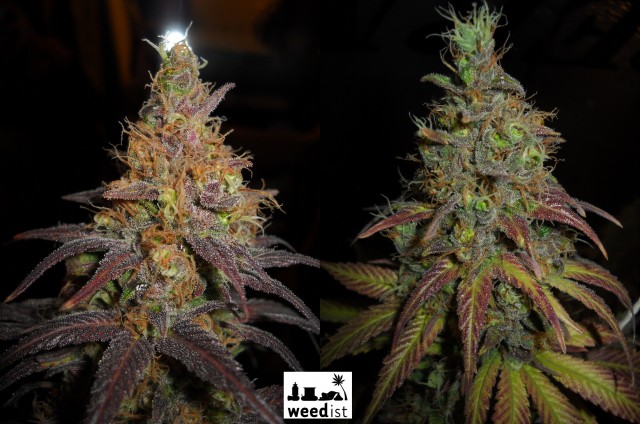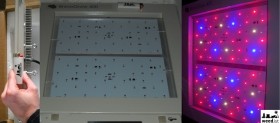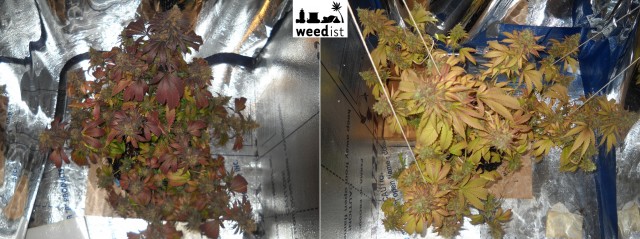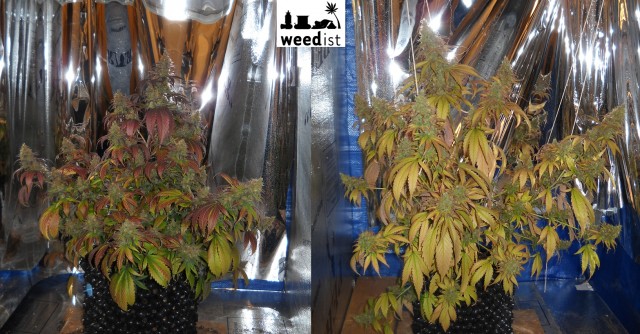The results are in: The HPS weighed in heavier, potency was identical, but color and flavor were better from the RhinoGrow.
In part 1 of our series comparing the performance of the RhinoGrow 400 LED grow light (172 watts) to a 400-watt high pressure sodium (HPS) lamp, we described the growing space and the starved state of the test plants.
In part 2, we followed the plants from the vegetative stage of growth until they stopped growing taller (commonly referred to as the ‘stretching’ stage). We noted that the HPS plant grew taller with larger leaves and more bare stem than the LED plant, which grew compact and bushy, similar to growing under sunlight or a metal halide lamp.
As the plants built their buds and ripened, not much difference between the two was observed.
Both built buds quickly and the sizes of the buds were similar. The LED plant’s buds began swelling slightly later than the HPS, and the lengthy stems of the HPS plant needed support. These were the only detectable differences until about a week before harvest. That’s when I asked the grower to turn off the grow lights so I could take some true-color photos. What I saw completely blew me away!
The HPS plant looked about the same under normal light (daylight fluorescent, 5000K spectrum). It was very yellow throughout the leaves with reddish areas and dark stems. The LED plant, however, was much more beautiful than I could tell from under the RhinoGrow. The leaves were almost completely purple with the same reddish areas and stems, and the buds had begun to take on a purple hue.
During the last week of ripening, the red areas on both plants deepened to a burgundy color I’ve rarely seen in cannabis. The buds of each also ‘purpled-up’ a bit, though the HPS has only slight purple tones in the top buds. The LED plant has purple throughout most of the buds.
All in all, the HPS plant harvested 52 grams of dried buds and was 25″ tall at harvest. The LED plant harvested 42 grams (80.8% of the HPS) and was 21″ tall at harvest. The HPS plant was bushier, taking up the full 30″ x 30″ space and the LED plant was conical, taking up approximately 2′ x 2′.
 The buds from both are quite potent. Great daytime bud for getting your head together, with a very uplifting and relaxing high. Both have been excellent for relieving stress and reducing anxiety, which have been plaguing me lately.
The buds from both are quite potent. Great daytime bud for getting your head together, with a very uplifting and relaxing high. Both have been excellent for relieving stress and reducing anxiety, which have been plaguing me lately.
The HPS buds smell more earthy than the LED buds, though both have powerful aromas. Grind up a bowl and the whole house knows, so I’m told. The HPS plant has great flavor, but is overbearing and thick, leading to coughing fits. The flavor of the buds was much smoother from the LED plant, which has the same flavor and is much easier on the lungs. In my opinion, neither buds taste anything like Juicy Fruit gum. Since the plants were purchased as clones, it is possible that these plants are not the Fruity Juice that they were advertised as. This is (unfortunately) a common problem with some dispensaries in Denver right now.
Results Summary
- Height: LED 21″ – HPS 25″
- Width: LED 2′ x 2′, conical – HPS 30″ x 30″, bushy
- Harvest Weight: LED 42 g – HPS 52 g
- Potency: LED 9/10 – HPS 9/10
- Appearance: LED 9/10 – HPS 7/10
- Flavor: LED 8/10 – HPS 7/10
- Aroma: LED 10/10 – HPS 10/10
- Electricity Cost (@ $0.12/kWh): LED $18.82 – HPS $43.78













